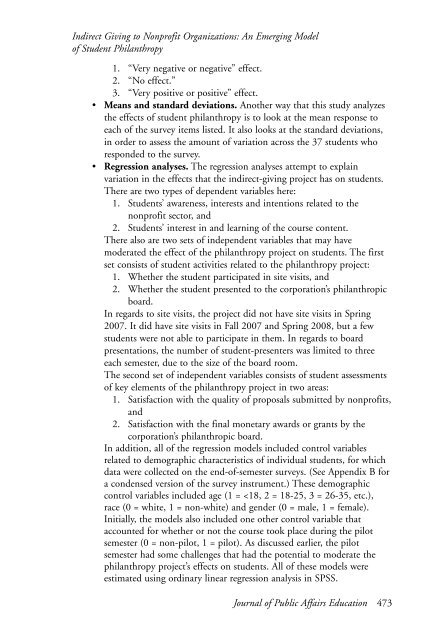JOURNAL OF PUBLIC AFFAIRS EDUCATION - National ...
JOURNAL OF PUBLIC AFFAIRS EDUCATION - National ...
JOURNAL OF PUBLIC AFFAIRS EDUCATION - National ...
You also want an ePaper? Increase the reach of your titles
YUMPU automatically turns print PDFs into web optimized ePapers that Google loves.
Indirect Giving to Nonprofit Organizations: An Emerging Model<br />
of Student Philanthropy<br />
1. “Very negative or negative” effect.<br />
2. “No effect.”<br />
3. “Very positive or positive” effect.<br />
• Means and standard deviations. Another way that this study analyzes<br />
the effects of student philanthropy is to look at the mean response to<br />
each of the survey items listed. It also looks at the standard deviations,<br />
in order to assess the amount of variation across the 37 students who<br />
responded to the survey.<br />
• Regression analyses. The regression analyses attempt to explain<br />
variation in the effects that the indirect-giving project has on students.<br />
There are two types of dependent variables here:<br />
1. Students’ awareness, interests and intentions related to the<br />
nonprofit sector, and<br />
2. Students’ interest in and learning of the course content.<br />
There also are two sets of independent variables that may have<br />
moderated the effect of the philanthropy project on students. The first<br />
set consists of student activities related to the philanthropy project:<br />
1. Whether the student participated in site visits, and<br />
2. Whether the student presented to the corporation’s philanthropic<br />
board.<br />
In regards to site visits, the project did not have site visits in Spring<br />
2007. It did have site visits in Fall 2007 and Spring 2008, but a few<br />
students were not able to participate in them. In regards to board<br />
presentations, the number of student-presenters was limited to three<br />
each semester, due to the size of the board room.<br />
The second set of independent variables consists of student assessments<br />
of key elements of the philanthropy project in two areas:<br />
1. Satisfaction with the quality of proposals submitted by nonprofits,<br />
and<br />
2. Satisfaction with the final monetary awards or grants by the<br />
corporation’s philanthropic board.<br />
In addition, all of the regression models included control variables<br />
related to demographic characteristics of individual students, for which<br />
data were collected on the end-of-semester surveys. (See Appendix B for<br />
a condensed version of the survey instrument.) These demographic<br />
control variables included age (1 =

















